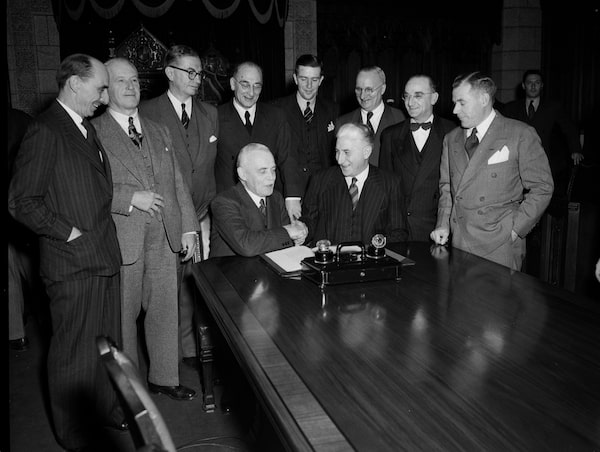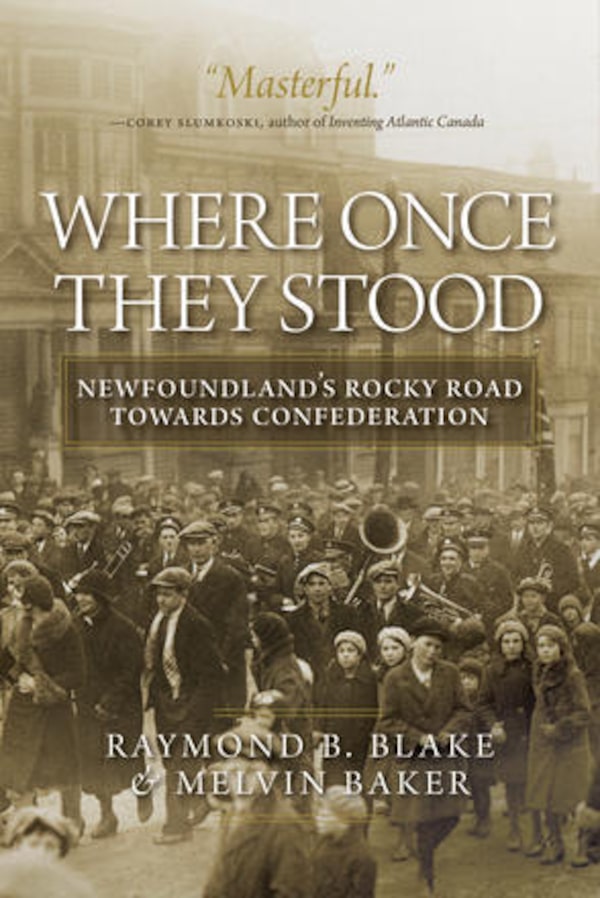
Delegations from the Newfoundland and Canadian governments sign the agreement admitting Newfoundland to Confederation on Dec. 11, 1948.NATIONAL FILM BOARD/National Archives of Canada/Canadian Press
- Title: Where Once They Stood: Newfoundland’s Rocky Road Towards Confederation
- Authors: Raymond B. Blake and Melvin Baker
- Genre: History
- Publisher: University of Regina Press
- Pages: 384

Handout
The first thing I sought, before I even folded back the front cover, was the origin of this book’s main title: Where Once They Stood. It felt fraught with meaning and I felt like an idiot for not recognizing it. A variant (“Where once our fathers stood, we stand”) also appeared on the banner of a publication, The Independent, put out by the Responsible Government League in the late 1940s. Turns out it’s a lyric from the province’s 1902 anthem Ode to Newfoundland.
“As loved our fathers, so we love / Where once they stood, we stand.”
This book, by historians Melvin Baker and Raymond B. Blake, is an important and insightful contribution to Canada’s evolving story, as it helps expand understanding of the relationship between Newfoundland and Canada. It gives lie to what the authors note was a common idea that it was “largely illiterate fisherman and outport people” who kept Newfoundland from joining Confederation in 1869 (their first referendum on the idea). The “ignorant and avaricious outporters” were again blamed, by many, including anti-Confederation St. John’s businessman P.E. Outerbridge, for handing Newfoundland over to Canada “as a free gift” in 1948 (after second and third referendums). Baker and Blake make the case that it wasn’t ignorant rural folk but politically engaged voters who made the right choice for Newfoundland on both occasions.
It might be hard for a contemporary Canadian to realize how divisive was the question of Newfoundland joining Confederation, particularly if memories are hazy on a reasonable contemporary comparison: the national consternation caused by Quebec’s referendums on separation in 1980 and 1995. The 1948 question split families and communities, and not all the discussion was civil. One anti-Confederation publication said in March, 1948: “Don’t Sell Your Soul to Feed your Body.” The same publication’s front page also said to voters: “You can sell Newfoundland only once, for Confederation is final. Once in, you stay in!”
Newfoundland actually came to Confederation talks in Quebec as observers in 1864; speaker of the House Frederic Carter and Opposition leader Ambrose Shea appear in the noted Livernois “International Convention at Quebec” photograph and so are included among the 30-plus men considered “Fathers of Confederation.” Carter and Shea took Quebec’s 72 resolutions to the Newfoundland House of Assembly when they returned, giving the initiative their “enthusiastic recommendation,” but it was “simply annihilated.”
Baker and Blake reiterate and re-examine default explanations for Newfoundland turning away from Confederation in 1869 (the Irish population suspicious of British North America, long memories of military conflict with the French and Quebec, the feared threat of military conscription or new taxes) and consider different analyses. These include economic and sectarian pressures of the mid-19th century on Newfoundland’s 162,000 souls. A number of poor years in the fishery (employing 90 per cent of the population) in the 1860s had contributed to the colony enduring a severe depression. Denominational schools, low literacy levels and the British/Irish divide continued to have an effect, as did limited education options and little economic diversity.
The standout fact is this: In 1869, 150 years ago, 78 per cent of voters (white and male) voted in a referendum on joining Confederation, and decided to maintain their discrete North Atlantic identity and connection to Britain. Sir Stephen Hill, pro-Confederation Governor of Newfoundland at the time, felt it had been a “fatal error” to put the question to a vote. He said, "the mass of voters in this colony … are an ignorant, lawless, prejudiced body, the majority of whom … are unfit subjects for educated and intellectual men to attempt to reason with on the advantages of Confederation.”
Despite this initial electoral shellacking, Blake and Baker note the Confederation question played a role in pretty much every election subsequent, even though it was almost 80 years until it was again put to a vote. The authors write evocatively and exhaustively about changes in the intervening years; by 1948, things were both different and the same.
Newfoundland changed as a political entity as a result of the First World War, the rise of the Fishermen’s Protective Union, and a crushing economic emergency during the Great Depression; 1934 saw the colony suspend responsible government (in place since 1855) and accept a six-member Commission of Government, in exchange for debt guarantees from Britain.
The Second World War also changed things; Newfoundland was “included in Canada’s defence preparations” and a 1941 lease agreement to construct U.S. military bases there reinforced a long-standing relationship with the Americans. (Joining the United States was a referendum option in 1948, “even [though] the United States had never expressed an interest in annexing Newfoundland.”)
Blake and Baker show clear evidence of a journey by Newfoundland’s voters (including, by 1948, women, but not Indigenous people) from a “political and constitutional” notion of citizenship to the more all-encompassing “social citizenship, based on economic and social as well as political rights.”
Confederation was never far from the bubbling surface of political discourse in the 79 years between referendums. Blake and Baker posit that joining Confederation narrowly won (with 52.3 per cent) 1948’s second referendum (a first didn’t result in a majority) because it offered, “full participation in Canada’s economic, social, and political life, something an independent Newfoundland could not provide.”
The authors contend that while the long-range answer to the question “How has it all turned out for Newfoundlanders and Labradorians?” remains complex, the “simple answer is that Newfoundlanders benefitted immensely from union, especially if one accepts that the decisive factor in the 1948 campaign was social citizenship.”
And, as was noted by one writer at the time, in joining Confederation, Newfoundland was “yielding its ancient independence, but not its identity.”
“As loved our fathers, so we love/ Where once they stood, we stand /Their prayer we raise to heav’n above / God guard thee Newfoundland.”
Expand your mind and build your reading list with the Books newsletter. Sign up today.